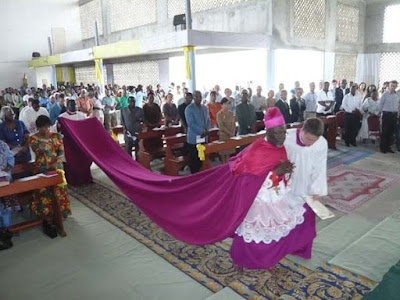 |
| source: CNEWA |
De-Latinization. The process of removing anything foreign to the integrity of a rite of the Church. More precisely, it is the process of removing vestiges of the Roman rite and Latin spirituality from the various rites and traditions of the Eastern Churches. It is something praiseworthy and laudable for Eastern Christians to aspire to pray like their long gone ancestors, who were met with the eternal reward for their own spiritual triumphs. It all seems rather obvious, does it not?
My first exposure to Greek rite Christianity came hand in hand with my first exposure to quibbles and quarrels over Latinizations. An elderly Melkite priest, I was told, would celebrate a spoken, "low" version of the Divine Liturgy during the week and rather than using a traditional prosphera (round bread) he would roll the dough into a cylinder, bake it, and slice cross sections to give the shape of Roman hosts. He passed and the two successive pastors did not continue this distinctively un-Eastern practice of a "low" Eucharist with Romanesque bread.
Some cases are a little less clear cut and get messy when involving the person cost of such purifications. My own Ukrainian Catholic parish did away with the out-of-place Stations of the Cross from the back of the church five years ago, something I mentioned in a
post only to incur the wrath of a Ukrainian Catholic who accused me of diminish the spiritual heritage of other Ukrainian Catholics. We had no trouble getting rid of these iconographic Stations in our parish because they had never been used; they were donated some years ago and hung in the back for decoration. Another Ukrainian parish, this time in the Northeast, does have Stations of the Cross and they use them on Good Friday for Latin devotions instead of Burial Vespers and Jerusalem Mattins. This is not "good" liturgy, and yet it also is not the result of compulsory Latinization, the forced adaptation of Roman customs Geoffrey Hull decries in
Banished Heart. No, this sort of Latinization is volitional and willing, a way in which some Ukrainians have found a means to meditate on the Passion of Our Lord. This church is sparsely attended, nigh dead, but a renewal minded pastor might have to be careful in telling these elderly Ukrainians that they have been "doing in wrong" all those years.
What, then, is the desiderium of de-Latinization? Is it the removal of all Latin influence? Or only compulsory Latin influence?Is it the removal of all Latin influence? Or only compulsory Latin influence?
Orientalium Ecclesiarium states:
" All members of the Eastern Rite should know and be convinced that they can and should always preserve their legitimate liturgical rite and their established way of life, and that these may not be altered except to obtain for themselves an organic improvement. All these, then, must be observed by the members of the Eastern rites themselves. Besides, they should attain to an ever greater knowledge and a more exact use of them, and, if in their regard they have fallen short owing to contingencies of times and persons, they should take steps to return to their ancestral traditions."
This blog recently
recounted some strange practices in the revised Byzantine liturgy as used by the Ruthenian Catholic Church, namely the saying aloud of concluding prayers in the litanies that the celebrant would normally say silently as the deacon sings the litanies aloud. It is strange if only because the conclusion usually reiterates the exact intentions of the litany. Perhaps this was done before the Fall of Constantinople in 1453, but the liturgy for many centuries has dictated the celebrant pray these words silently or, if he reads the litany himself, that he omits them.
In a similar fashion, almost all the Eastern Catholic Churches, at least in the United States, ask for the anaphora to the sung aloud and for the celebrant
not to prostrate before the consecrated gifts after the invocation of the Holy Spirit during the
epiclesis. By contrast, priests in the "old world" will often recite the anaphora while the choir continues the Holy, Holy, Holy and the responses; usually they will prostrate at the descent of the Paraclete. These practices align with the norms of the Byzantine rite Orthodox Churches who more widely use these rites.
Eastern Christians often complain that Latin missionary presence or Latinization split the practices of local communities between the sects, so why would de-Latinization coincide with the modern adaptation of liturgical gestures and habits that contravene Orthodox norms? New Liturgical Movement recently published a
fascinating account of the Armenian Holy Sacrifice, a liturgy which features numerous Latin influences from Crusader times which the people of Asia Minor have not seen fit to discard, but that has not prevented some Armenian Catholics from dropping the Last Gospel. The Last Gospel may be Roman Catholic, but it is also Armenian Apostolic.
I suggest this: that de-Latinization should aim to create a normative rite in each Eastern Catholic Church on par with what their counterpart Orthodox Churches would practice. The Melkite Divine Liturgy often resembles the Antiochian Orthodox Divine Liturgy (and they often use each other's service books), but the Armenian Catholic Holy Sacrifice should approximate the Armenian Apostolic Holy Sacrifice. Let there be one rite for one people, saving any differences in proper texts between the Churches.
There are some harder cases, however, which I dare not approach. What of the Maronites, who have become so Latinized in the last four centuries that their original liturgy scarcely exists anywhere? Their bishops attempted a major restoration in 1968, but the congregations and the clergy generally rejected the move as being at odds with their own received spirituality, and unlike most Eastern Catholics, they have no dissident equivalent.











